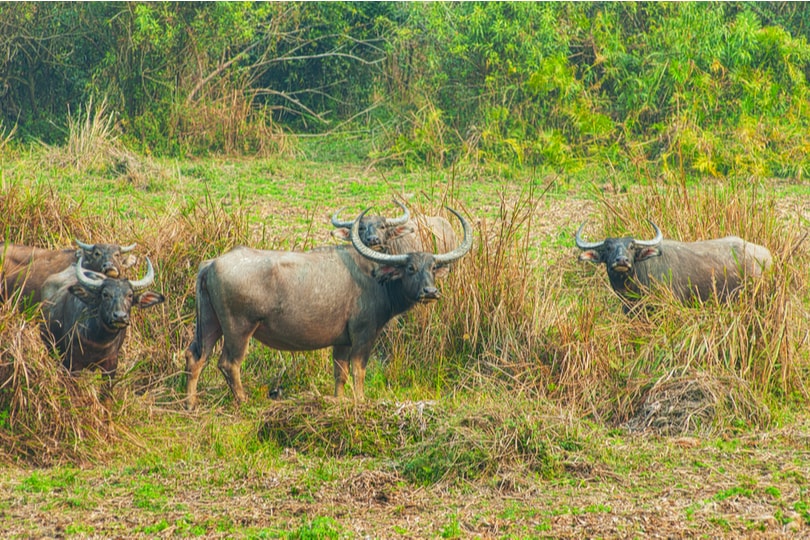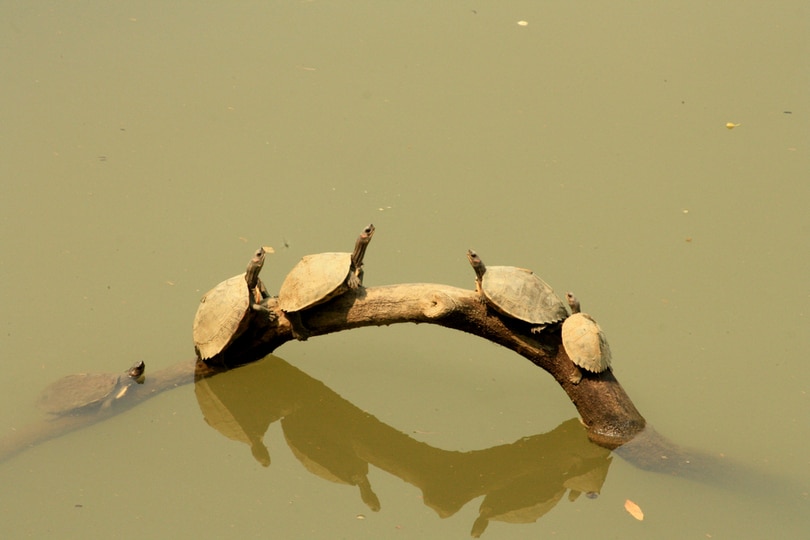The North-Eastern part of our country is unquestionably stunning with the natural beauty it has been blessed with. With such a wide range of biodiversity and culture, preserving them for the generations to come is an important mission that everyone must work towards. Assam has one such place of wildlife and ecological importance that has been preserved for several decades.
The Kaziranga National Park is known to hold two-thirds of the world’s single-horned rhinoceros population, and thanks to the tireless efforts of the government and wildlife organizations world over, they are thriving. To be able to look at this majestic species in its natural habitat is an awe inspiring experience. If you are lucky, you will be able to get close enough to observe these gentle beasts going about their day, unaware of their celebrity like status.
If you’re planning your next exciting getaway, Kaziranga National Park is the place for you. Being a World Heritage site, it’s not just about visiting the rhinos; Kaziranga is more than that. Whether you are a wildlife photography enthusiast, an eternally excited backpacker, or a family looking to travel together; there is a lot for each of you to experience here, no matter what you came for.
The immersive cultural experience found here, apart from the wildlife, will show you a side to Assam you haven’t seen before! In this article, we are going to cover everything you need to know about Kaziranga National Park of Golaghat.

This national park was established in 1905 by then Viceroy of India, Lord Curzon. It was an attempt to save and revive the diminishing numbers of the great Indian one-horned rhinoceros, which had reached a population of just 600. Originally set up as a reserve encompassing 252 Km, it was expanded by 152 sq Km all the way to the banks of the river Bhramaputra. Named a game sanctuary in 1916, it was renamed as Kaziranga Wildlife Sanctuary in 1950.
14 years later, in an effort to safeguard the rhinos and to protect the vibrant biodiversity found there, it acquired the status of a UNESCO World Heritage site. Today, people from all over the globe have Kaziranga National Park on their bucket list to witness majestic mammals walking free and safe in their own homes.
The National Park is open from 1st November to April 30th. If the weather conditions allow it, the park may open even in October.
The best time to visit would be mid-February to mid-March given the pleasant weather. The Kaziranga festival, which is an event unlike any other, is held from the 7th-11th February.
Travelling from any other part of the country to Kaziranga is a long journey. The following modes of transportation will help you reach here:
By Air: The closest airport to Kaziranga is in Guwahati. You can take a taxi to Kaziranga National Park, which is 295 Km from there.
By Rail: Furkating is the railway station closest to the park. You can take a taxi to travel the 80 Km to the park.
By Road: Road trips are the best especially when you’re with close friends and adventurous people. Since Kaziranga National Park is so far away, you can travel to a prominent city like Guwahati, Tezpur, Jorhat or Naogaon by railways or air and then take a bus to Kaziranga.

Before your visit Kaziranga National Park, it is important that you know what to expect, so that you can make the best of your trip. By having an idea of the wildlife found there, you will be able to spot them easily and enjoy your trip even more.
The national park is divided by the forest authorities into 4 zones for easy accessibility and convenience. They are:
1) Mihimukh in Central Range at Kohora
2) Bagori in Western Range at Bagori
3) Agoratoli in Eastern Range at Agaratoli
4) Ghorakati in Burapahar Range at Ghorakati
In these zones, you will be able to spot the following species of stunning flora and fauna.
Mammals: Indian Pangolins, Chinese Pangolin, Hog Badger, Particolored Flying Squirrels, Chinese Ferret Badgers, Assamese Macaque, Golden Langur, Capped, Great Indian One-Horned Rhinoceros, Hoolock Gibbon, Eastern Swamp Deer, Wild Asiatic Water Buffalo, Elephants, Sambar, Gaur, Indian Muntjac, Hog Deer, Wild Boar, Indian Tigers, Jungle Cat, Leopards, Fishing Cat, Hispid Hare, Leopard Cats, Indian Gray Mongoose, Large Indian Civet, Small Indian Mongooses, Small Indian Civets, Golden Jackal, Bengal Fox And The Sloth Bear.
Birds: Indian White-rumped Vulture, Bengal Florican, Pale-capped Pigeon, the Great Indian Hornbill, Old World babblers, Wreathed Hornbill, Baya Weaver, Hodgson’s Bushchat, threatened Finn’s Weavers, Old World warblers, Black-breasted Parrotbill, Bristled Grassbird, White-fronted Goose, Rufous-vented Prinia Baer’s Pochard duck, Ferruginous Duck, Lesser Adjutant, Black-necked Stork, Greater Adjutant, Asian Openbill stork, White-bellied Heron, Blyth’s Kingfisher, Dalmatian Pelican, Nordmann’s Greenshank, Spot-billed Pelican, Black-bellied Tern, Greater Spotted, Eastern Imperial, White-tailed, Grey-headed Fish Eagle, Pallas’s Fish Eagle, Lesser Kestrel, Indian Vulture, drug Diclofenac, Slender-billed Vulture, Swamp Francolin.
Reptiles: Reticulated Python, Indian Cobra, Rock Python the King Cobra, Monocled Cobra, Common Krait, Russell’s viper, Monitor lizard, the Water Monitor, Bengal monitor, the Brown Tortoise and Assam Roofed Turtle.
Flora: Mimosa Invisa Dillenia Indica, Talauma Hodgsonii, Garcinia Tinctoria, Cinnamomum Bejolghota, Ficus Rumphii, Baguri, Haldibari, Bimali, Albizia Procera, Lagerstroemia Speciosa, Duabanga Grandiflora, Crateva Unilocularis, Grewia Serrulata, Sterculia Urens, Mallotus Philippensis, Aphania Rubra, Bridelia Retusa, Leea Indica, Water Hyacinth, Leea Umbraculifera, Aphanamixis Polystachya

There are two kinds of safaris for visitors to enjoy at Kaziranga National Park. The elephant and jeep safari are things you can look forward to as they are an extraordinary way to have an exploratory journey around the forest. However, you will have to make your bookings well in advance for the elephant safari since it has limited spots. While elephant safaris are available only in the Central and Western range, the jeep safari is available in all areas of the park.
The scheduled times for the both are given below.
1) Elephant Safari: 5:30-7:30 and 15:00-16:00
2) Jeep Safari: 7:00-9:30 and 13:30-15:30
Once you embark on your trip through the national park, you are expected to pay multiple fees which are broken down as below:
1) Entrance Fee: INR 50 for Indian nationals and INR 250 for foreign nationals.
2) Vehicle entry Fee: INR 200
3) Camera Use Fee: INR 50 for Indian nationals and INR 500 for foreign tourists.
4) Video Camera Use Fee: INR 500 for Indian nationals and INR 1000 for foreign tourists.
5) Elephant Safari tickets: INR 280 for Indian nationals INR 750 for foreign tourists.
6) Jungle Jeep Safari Tickets: INR 1000 for Central Range and INR 2000 for Burapahar.
Here is a list of a few tips to keep in mind during your trip to Kaziranga national park for the best travel experience:
1) Explore the Central range to have the best elephant safari experience.
2) There are boat rides available for you to indulge in on the north-eastern side of the park.
3) You can take a private vehicle into the park if it is accompanied by an armed guard.
4) Try to avoid early morning safaris during winters as the fog obstructs your view.
5) Pick a group elephant safari because private safaris experience time cutting to take more groups on tour.
1) Stick to wearing light and comfortable clothing. Avoid bright colours to blend in with the forest.
2) Don’t forget to carry your camera.
3) Do not carry weapons and sharp objects.
4) Do not harm the flora and fauna of the national park as it is a criminal offence.
5) Put your phones on silent to avoid startling the wildlife. The park is also a no honking zone.

Visiting Kaziranga is about more than just the national park. There are several other places of significance that you will have a wonderful time exploring. Once you finish your tour and safari of the national park, head to these 5 sites for an immersive North-Eastern Experience.
Tea gardens are beautiful to look at and the ones at Kaziranga are no exception. You can stop by these beautiful and lush green gardens and catch a breather for a few peaceful minutes while you travel through Kaziranga. If you’re in luck, you may catch the locals diligently plucking the fresh leaves off these plants to send to the processing units.
Built in the heart of Jorhat, this golf resort is surrounded by tea estates. The golf resort is meant for professionals and is a training academy for serious golf enthusiasts.
Located just a few kilometres away from Kazirangs, the Deopahar Geological site dates back to the 9th century and attracts a lot of tourists. Here, you will witness thousands of butterflies of different kinds. The butterfly park is home to several kinds of exotic butterflies that are rarely seen outside their habitat.
Apart from the butterfly garden, Deopahar also has historical monuments that show you the heritage of Assamese culture. The site has a collection of Shiva temples and pre-Ahom era monuments.
Deopahar is the perfect place for your to understand the roots and origins of Assamese culture and traditions as their story is preserved along with ancient artefacts such as currency, jars, inscriptions and manuscripts.
The Orchid and Biodiversity Park is located 2 Km away from Kohora and is heaven for people who love gardening. There are 16 bighas of land dedicated to displaying over 500 varieties of beautiful orchids. These flowers are found only in North-Eastern India and hence are extremely famous.
The Biodiversity Park has a variety of over 200 medicinal plants that are on the brink of extinction. Apart from this, there are local fruits, flowers and vegetables. There is also a lake where you could go boating, a greenhouse and a tortoise shelter for you to enjoy.
Every evening at 7, there is a cultural show for the visitors. If you’re not around during the day, you could catch a brief sneak-peak of the park in the evening. Each show lasts 10 minutes and is put on every 20 minutes.
What we loved most about this park was that it allowed us to taste the scrumptious local cuisine at super affordable prices!
The ethnic village is just 10 minutes away from the Orchid Park and showcases the lifestyle of the tribes in the Karbi-Anglong District. The twelve beautiful houses with different styles and decor on display will make you wish you could actually stay in one of them. Outside, you will find various sculptures depicting the tribals going about their daily life.
The North-East has a lot to offer to tourists. Since we are close enough to be able to visit easily, we should grab this opportunity by both hands and make a trip to Kaziranga National Park.

Please go back to portrait mode for the best experience